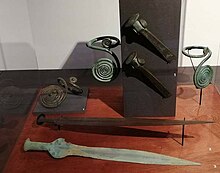The Wietenberg culture was a Middle Bronze Age archeological culture in central Romania (Transylvania) that roughly dates to 2200–1600/1500 BCE. Representing a local variant of Usatove culture, it was contemporary with the Ottomány culture and Unetice culture and was replaced by the Noua culture. Its name was coined after the eponymic Wietenberg Hill near Sighișoara.
| Geographical range | Romania (Transylvania) |
|---|---|
| Period | Bronze Age |
| Dates | c. 2200 BC – 1500 BC |
| Preceded by | Coțofeni culture, Usatove culture |
| Followed by | Noua-Sabatinovka culture |


People of this culture traded with the Mycenaeans. Burial sites contain bronze battle axes and maces with stone heads. Pottery consists of amphorae with spiral and meandric ornament.
By 1964, about 200 settlements of this culture were discovered.
Gallery edit
See also edit
Notes edit
- ^ Tarbay, J.G. (2020). "The Essence of Power: A Middle Bronze Age Gold Armlet from Tápióbicske (Central Hungary)". Communicationes Archaeologicae Hungariae. 2020: 19–55. doi:10.54640/CAH.2020.19. S2CID 247432298.
- ^ "Apa hoard". Institute for the Study of the Ancient World. 21 September 2022.
- ^ Gimbutas, Marija (1965). Bronze Age Cultures in Central and Eastern Europe. De Gruyter. p. 56. ISBN 9783111668147.
That Transylvania was in the center of trade in gold and that its sources played the most important role over all eastern central Europe and in the western Pontic area is indicated by large gold treasures like those from Șmig in eastern Romania ... The Tufalau and Șmig hoards are presumed to belong to the Wietenberg cultural group of eastern Transylvania.
- ^ "Romania - Bronze Age. Gold plates. Bucharest, Muzeul National De Istorie Al Romaniei".
References edit
Wietenberg ohne Mykene. Gedanken zu Herkunft und Bedeutung der Keramikverzierung der Wietenberg-Kultur von Laura Dietrich und Oliver Dietrich, Berlin (2011)
This section is empty. You can help by adding to it. (March 2013) |
External links edit
- Golden axe of Tufalau
- Культура витенберг Archived 2011-09-18 at the Wayback Machine
- Бронзовый век Archived 2012-03-31 at the Wayback Machine
- Wietenberg pottery
- Wietenberg hearth plate from Sighisoara-Wietenberg